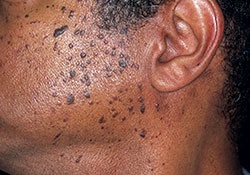A Common Variant of Seborrheic Keratoses
My prior post discusses seborrheic keratoses (SKs), and I think a subsequent post on a related condition – one that is in the SK family – is fitting.
“Here is a 46-year-old man who presented for evaluation and treatment of multiple, clustered dark brown papules that he reports have been increasing in both number and size over the past four to five years. The patient also reports that several senior members of his family have similar lesions.”
Diagnosis: Dermatosis Papulosa Nigra
Dermatosis Papulosa Nigra (DPN) is a genetic condition seen in many people, especially in people of color. Under a microscope, the lesions are very similar, if not identical, to small seborrhoeic keratoses, though they may appear earlier than their counterparts, the larger seborrheic keratoses on the body. In most cases, DPN is an aesthetic concern for persons, but when these lesions exist in the beard region, they may be pruritic (itchy) or irritated by shaving. Like large SKs, even when asymptomatic, they frequently motivate a dermatology visit. The majority of DPN lesions occur on the face and neck, but they also can occur on the chest and back.
Treatment of DPN
Given their propensity to grow in visible locations and in large numbers, the most common approach to the treatment of DPN is light hyfrecation. Before starting, a dermatologist will usually (and advisably!) apply a topical anesthetic (numbing) cream for 15-30 minutes because the procedure is slightly painful, followed by superficial hyfrecation, or burning, of all the papules until they turn a light grey in color. Afterward, the provider may perform gentle curettage, or scraping off, of remaining lesions, or she may allow residual lesions to scab and fall off on their own (which typically occurs in a matter of days). Next, she will perform a soft massage of the treated sites with gauze to stop any bleeding. At home, the patient should apply a topical moisturizer, such as petroleum jelly, or an antibiotic cream to the treated sites at least twice daily over the next week or so to improve healing.
On average, approximately 70 percent of the treated lesions will require no additional treatment, unless they recur down the road. About 30 percent will develop a mild to moderate post-inflammatory hyperpigmentation that generally self-resolves over time, but resolution can be expedited by employing a topical lightening preparation that a dermatologist can prescribe, provide, or recommend.




Leave a comment